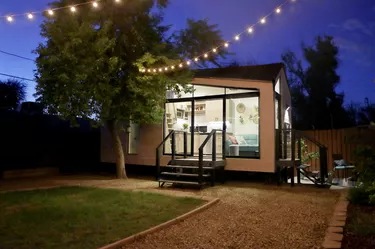
Whether you're looking for a cheaper alternative to buying a regular home in this hot housing market or you're interested in a minimalist, environmentally friendly or flexible lifestyle, tiny houses have become a popular option, especially over the last decade. You can find tiny home options that range from revamped garden sheds to fancy multi-floor buildings with a luxury look, and you can buy pre-built models or build your own. While tiny house living can have its advantages, you'll need to understand the drawbacks, costs and financing options. Here are three things to think about if you're considering tiny home living.
1. What's a Tiny House Like?
Video of the Day
If you're considering a tiny house, you're probably wondering, "How big is tiny?" While some may exceed the range slightly, these homes usually have 100 to 400 square feet of space. This is far smaller compared to the 2020 median new single-home size of 2,261 square feet, so tiny homes offer a cozy experience and require creativity for organization.
Video of the Day
Along with having a tiny size, these homes can look a lot different than a traditional home since they come in so many styles. You might have seen tiny homes resembling cute cabins or fancy sheds on popular real estate and travel TV shows. However, you can also make a tiny house out of RVs, buses, trailers, boats and shipping containers as well as choose from unique dwellings like yurts and wagons.
Depending on the type you have, a tiny house might reside somewhere stationary on a permanent foundation or have wheels so you can move it from location to location. Some owners purchase land where they have the tiny home hooked up to utilities, while others live off the grid or place their tiny house in a community with other owners. If you use an RV, your tiny house might stay on the go most of the time for a flexible lifestyle.
2. Why Live in One and Why Not?
If you're looking at the financials of buying a tiny house vs. renting an apartment or buying a single-family home, the potentially lower price tag is one of the benefits that boosts their popularity. Depending on the type of tiny house you buy, you can often find models as low as $10,000 and potentially avoid needing financing. However, you'll need to consider any costs to add on for land, utility setup or upgrades too.
Tiny houses can also offer good aesthetics, require fewer resources such as electricity and save time on cleaning due to the smaller space. There's also the flexibility that comes with tiny houses you can easily move around to new locations as you desire.
However, tiny home living can also come with drawbacks since you'll have much less space for organizing your possessions and having people come over. You'll also need to consider potential challenges such as finding a place for your tiny home, handling the legal aspects such as zoning and getting desired utilities set up. Potential owners also experience fewer options for financing the home and the potential for a low resale value later on. Further, tiny doesn't always mean cheap since some can exceed $100,000, so your savings can vary.
3. How Do You Buy a Tiny House?
You have plenty of options to buy a tiny home online or in person. For example, you can buy base models and kits to build your own tiny house through general retailers like Amazon, Lowe's and Home Depot. Makers like the Tumbleweed Tiny House Company allow you to buy customize models that come ready to hook up at your location, while tiny home communities can have homes ready to rent or buy. You can also try looking through your local real estate listings both for land and tiny homes.
If you need financing for your tiny home purchase, you likely won't have luck with a mortgage unless you buy a larger tiny home with a permanent foundation and need to borrow $50,000 or higher. Instead, you can look into options like getting a personal loan, using a high-limit credit card or seeking installment plans available through tiny home manufacturers directly. If you plan to buy a tiny house as a second home, you may qualify for a home equity loan and use those funds.
- ABC News: Living in a Tiny Home: Benefits & Drawbacks
- Realtor.com: What Is a Tiny House? A Huge Trend Explained in Simple Terms
- Quicken Loans: Tiny-Home Financing: Is It Hard to Get a Loan?
- Bob Vila: Solved! Where to Buy a Tiny House
- Salter Spiral Stair: Tiny Home Styles & Designs
- U.S. Census Bureau: Highlights of Annual 2020 Characteristics of New Housing